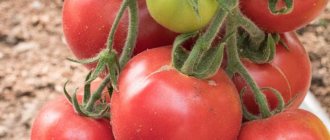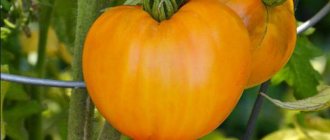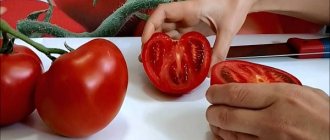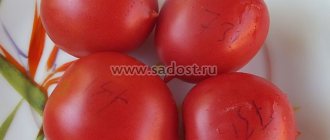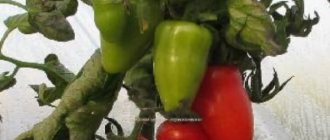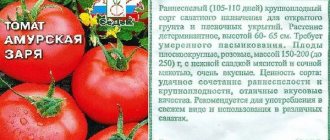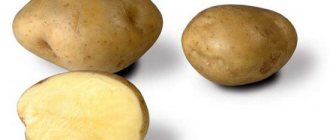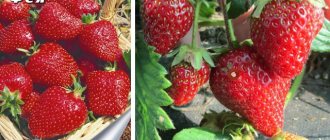The German red strawberry tomato is shaped like this particular berry. It is very popular among Russian tomato connoisseurs and once even made it into the top ten most favorite varieties of Russians. All thanks to the wonderful taste and aroma.
| Height | Landing location | Ripening time | Fruit color | Fruit size | Origin | Fruit shape |
| Tall | Greenhouse, Open ground | Mid-early | Reds | Large | Variety | Heart-shaped |
Description of the variety
Description of the variety:
Fruit:
- Round-heart-shaped, have a slightly elongated and rounded tip;
- Not ripe - light green in color, in a state of ripeness - rich red, uniform color;
- With a thin, glossy skin that reliably protects against cracking;
- With juicy, fleshy, sugary red flesh;
- With a pleasant, richly sweet taste, with subtle fruity notes and light sourness;
- The number of seed chambers is from 3 to 6, with few seeds;
- Dry matter content - 5%;
- Sugar content - 2.3%;
- Large sizes. Proper care allows you to get fruits weighing from 300 to 500 grams.
The average weight is from 150 to 300 grams.
Bushes:
- Indeterminate type, with moderate formation of green mass;
- Tall. When grown in unprotected soil, they reach a height of 180 cm; in greenhouse conditions they grow up to 250 cm;
- The leaves are medium-sized, dark green in color;
- Inflorescences of a simple type. The formation of the first occurs after 7-8 leaves, the rest with an interval of three leaves.
Outline of the German Red Strawberry variety
The German Red Strawberry is a semi-child, occupying an intermediate position in the trend between the tall and short type. The semi-determinate German Red Strawberry is an early ripening variety with 98-116 days of ripening.
The height of the plant is up to 2.2 m when grown in film shelters and 1.7 m when cultivating tomatoes in open ground. The key stem of the German Red Strawberry ends its development with the formation of 9-12 inflorescences, where the first of them is formed above the 7-8 leaf, continuing development through the next 3. Tomato leaves are openwork light green in color. The fruits of the German Red strawberry, formed on a flower cluster of 4 to 7 pieces, are distinguished by a non-trivial shape, similar to a voluminous heart or a very large strawberry weighing from 200 to 400 g of a rich red color. The yield from one bush with proper use of agricultural practices reaches 5-7 kg.
Tomatoes: advantages and disadvantages
The characteristic features of the German Red Strawberry tomato include:
- Early ripeness;
- Friendly maturation;
- Excellent taste of fruits;
- Original form;
- Easy to care for;
- Immunity to diseases typical of tomatoes;
- Large fruit;
- Good yield;
- Excellent keeping quality;
- Possibility of transportation.
Among the disadvantages of the variety are:
- The need to form a bush;
- The need for mandatory tying to reliable supports.
Farmer reviews
Farmers note the interesting shape, bright tomato taste, color and size of the fruit. Tomatoes are suitable for fresh consumption in salads and for canning. In addition, German red strawberries have earned positive reviews for their easy care. However, some people do not like the variety - due to the need for pinching and bush formation.
Irina Dudina, Moscow region: “This year I planted orange strawberries.
The normal color is bright orange, amber or yellow depending on the cross. The fruits can be used fresh or for making jam, juices, and pickling. This year a whitefly attacked, but we got rid of it quickly and the tomato was not damaged.” Lyubov Ilyasova, Samara: “I liked the variety for its yield, the whole bush was covered in tomatoes. They write that keeping quality is poor, but I forgot the ones I picked in the basin for a month - not a single one went bad. The color of ripened fruits varies: from pinkish to bright red. Very tasty! I left the seeds. I’ll definitely plant more.”
Elena Kudrina, Belgorod: “The height of the bush is 2 meters, the weight of the fruit is 350 g, the beautiful shape is a heart. Insanely delicious, aromatic, juicy, sweet! The bush is huge and knits from the beginning to the end of the bush. High-yielding! I was amazed by my power. This is the first tall, large-fruited variety that bears fruit all over the bush. I highly recommend boarding!”
Andrey Timakhov, Rostov-on-Don: “The fruits of German berries are tasty and of the correct shape only when the soil is fertile, when there is constant fertilizing and sufficient watering. You also need to remember to form the bush into two stems, no more, otherwise the food will go into the foliage. These nuances can be considered disadvantages, but there are a lot of advantages: tasty, juicy, and store well.”
Growing tomatoes
The specific method of growing tomatoes is determined by the climatic conditions of the growing region.
How to prepare seeds?
Seed material is pre-disinfected with hydrogen peroxide or manganese solution. Then soaked in a growth stimulator. Such procedures are mandatory for self-collected seeds. Seed material purchased from a specialized store does not require additional processing.
Sowing seed material
Description:
- Seeds are sown for seedlings in early to late March;
- The substrate should consist of garden or turf soil and humus. You can add a small portion of washed river sand. To increase the nutritional value of the soil mixture, it is possible to add wood ash or superphosphate;
- The seed material is slightly buried, sprinkled with soil on top and sprayed with water;
- In order for the seeds to germinate quickly, the temperature should be from +23 to +25 degrees;
- Containers with the first sprouts are moved to bright light;
On cloudy days, they are additionally illuminated with fluorescent lamps.
- Water the young bushes with warm water as soon as the soil dries out a little;
- As soon as the first pair of true leaves unfold, they begin picking. Afterwards, fertilizing is carried out with complex mineral fertilizer;
- Before planting, tomato seedlings must be hardened off, especially if they plan to grow them in open ground. The containers are left outdoors for a couple of hours at first, gradually increasing the time spent outside.
Rules for planting seedlings
Description:
- You can plant tomato bushes in greenhouse structures in the second half of May, in unprotected soil - in June, using film cover for the first time;
- Preliminary disinfection of the soil is carried out with a pale pink manganese solution. Also, the soil needs to be loosened and a large amount of humus added;
- The interval between the bushes and the row spacing are identical and amount to 60 cm, respectively, from 3 to 4 seedlings are planted per 1 m2.
Landing
The seeds are soaked in a 1% potassium permanganate solution to strengthen the immune system. For seedlings prepare the soil from:
- 1 part turf soil;
- 2 parts of peat, preferably non-acidic (if its acidity is above pH 6.5, add dolomite flour or chalk);
- 1 part compost;
- 0.5 parts sand.
The substrate is also disinfected with potassium permanganate and the washed seeds are sown. They are germinated in a warm place with a temperature of at least +23. When sprouts appear, transfer to a cooler and well-lit place.
Dive into separate pots (preferably peat) with the appearance of two leaves. If necessary, fertilize. Hardened bushes no lower than 20 cm are planted on the site.
A distance of 50 cm or more is maintained between indeterminate tomato bushes.
Diseases and pests
The tomato variety "German Red Strawberry" has good immunity to most diseases. He is not afraid of fungal and viral diseases, however, preventive measures are necessary:
- A mandatory pre-planting watering of the soil with a manganese solution is carried out;
- During the late blight epidemic, plantings are sprayed with copper-containing preparations;
- The occurrence of crown and root rot can be avoided by treating with “Fitosporin” or other non-toxic biological preparations;
- Conduct regular inspections of plantings for the presence of insect pests. Insecticidal preparations or a decoction of celandine are effective against thrips, spider mites and whiteflies. The use of toxic agents is recommended only before the flowering period begins. Aqueous ammonia solution is very helpful in the fight against slugs. To wash off aphids, use a warm solution of laundry soap.
Transplantation into the ground
Orange Strawberry tomatoes can be planted in the ground in early May, by which time the seedlings have all the necessary characteristics to successfully undergo transplantation.
Plants should be placed so that they are 1.5-2 centimeters above the ground level. It is best to replant a tomato with a clod of earth in which it grew. After planting, the plants are watered from below so as not to damage the leaves. The planting density of German Strawberries for open ground is 3 plants per square meter, and for a greenhouse - 2 plants.
We suggest you read: How to properly replant root parsley?
For better yield in greenhouses, it is recommended to form the plant into one stem. Pruning should be done once a week. In this case, the side stems are removed and the top of the plant is tied up.
You should also remove damaged lower leaves in a timely manner. This will ensure normal air circulation and help reduce the incidence of gray mold.
Reviews about the variety from those who planted
The external original appearance of the fruit, taste characteristics, excellent immunity and early ripening make the tomato variety “German Red Strawberry” in demand among domestic vegetable growers.
Growing old varieties, proven by time and vegetable growers, is the best option for beginners in gardening. The tomato variety “German Red Strawberry” should be planted in a greenhouse or in the garden. The ability to independently collect seed material allows you to grow tomatoes from year to year, while maintaining all maternal qualities.
Review from a gardener:
Disadvantages of the variety
The Orange Strawberry variety does not have any significant disadvantages, but it does cause some inconvenience when growing. They consist in the fact that it needs to be shaped, since the bush is quite voluminous and tall. As a rule, in greenhouses, German Strawberries are grown in one stem. If planted in open ground, pinching may not be carried out.
Gardeners also note that this variety is very dependent on fertilizing. If you grow it on poor soils, there is a possibility of a decrease in yield.
Tags: strawberry, German, description, variety, tomato
About the author: admin4ik
« Previous entry
Tomato Orange German Strawberry: characteristics and description of the variety, yield with photos
The appearance of the variety
The German Orange Strawberry tomato belongs to the genus of so-called relict (hereditary) plants and was created by German gardeners more than fifty years ago. This means that this variety is not a hybrid. Plants classified as relicts have excellent consumer qualities, primarily in terms of taste.
The Orange Strawberry tomato has been passed from hand to hand, from generation to generation, so it is several times superior to hybrid varieties in resistance to chemicals and various diseases.
Over so many years of cultivation, this variety has acquired a reputation as a tasty and unpretentious tomato, which you will undoubtedly want to plant again.
Characteristics of tomato Orange strawberry
Indeterminate tomatoes of the Orange strawberry variety are grown in greenhouses, greenhouses and open ground. In closed ground, if the growth of the plant is not limited, the bush can reach a height of 4 m. In open ground, its maximum height is 2 m. The variety is a medium-late variety - the first ripe fruits are obtained 120 days after germination.
In the central region, this period occurs at the beginning of August. Orange strawberries are intended for growing in any climatic conditions. However, in the middle zone, the declared yields can be obtained only in greenhouses; in the southern regions, tomatoes do not require shelter. The variety is adapted to any weather conditions, withstanding short-term droughts and short-term decreases in temperature.

